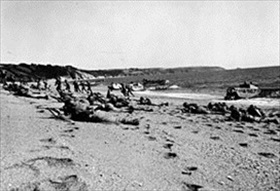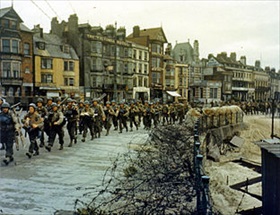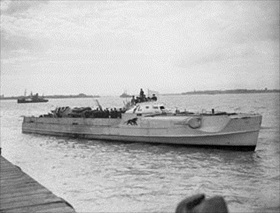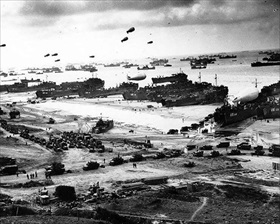DRY RUN INVASION ENDS TRAGICALLY
Slapton Sands, Devonshire Coast, Southwest England · April 28, 1944
Shortly after midnight on this date in 1944 German torpedo boats (E-boats, or Schnellboote in German) on a routine patrol out of Cherbourg in occupied France suddenly found themselves in the middle of Operation (or Exercise) Tiger (codenamed T‑4), a convoy of eight American LSTs (landing ship tanks) and their British escorts that were engaged in a live-fire dress rehearsal of the D-Day invasion of Normandy that would take place six weeks later. The LSTs were crammed with amphibious vehicles, jeeps, and trucks, along with 30,000 soldiers in full battle gear. The nine German nighttime interceptors were each over hundred feet long, armed with two torpedoes and two 20mm cannons, and painted black for camouflage. Capable of traveling at 40–50 knots/hour for as many as 700 nautical miles, they were designed to wreak maximum havoc in the English Channel, and on this night in Lyme Bay close to Slapton Sands they did. At the time the Germans succeeded in getting close enough to the Tiger convoy to launch their torpedoes, they had no idea what the slow moving ships and the heavier than normal radio traffic meant. In quick succession the Schnellboote crippled one LST, caused another to burst into flames, trapping many of the victims below deck, and sank a third one immediately. One quartermaster service company was virtually wiped out: 201 officers and men out of a total of 251 were killed outright, wounded, or succumbed to hypothermia in the cold channel waters. The official death count was 749 American service members, and for days bodies of soldiers and sailors washed up on the southwest coast of England. Those floating in the water were scooped up by small landing craft with their ramps lowered. Gen. Dwight D. Eisenhower, Supreme Commander of the Allied Expeditionary Force for the Allied gamble that had the potential for deciding the course of the war in Europe, ordered the dead be buried secretly in military graveyards, refused to decorate soldiers who had acted heroically in rescue operations, and placed the survivors in select camps under quarantine and a news blackout. Servicemen were threatened with court-martial if they leaked news of the tragedy. The deadliest American training incident of the war was an ominous precursor to D‑Day, June 6, 1944.
[amazon_carousel widget_type=”ASINList” width=”600″ height=”200″ title=”Recommended Reading” market_place=”US” shuffle_products=”False” show_border=”False” asin=”0857332341,0955569826,0709032668,0131277960,1591149975,1841764450,1849084068,0306814226,0788425129,0747575436″ /]
Dress Rehearsal for the Allied Invasion of France, April and May 1944
 |  |
Left: American troops practice beach landings in southwest England during a dry run for the invasion of Normandy, France. The nighttime tragedy off the coast of Devon near Slapton Sands, in which nearly 750 servicemen lost their lives, provided valuable military readiness lessons for Operation Overlord six weeks away.
![]()
Right: The 2nd Battalion, U.S. Army Rangers march to their landing craft in Weymouth, England, in this photo from June 5, 1944. The rangers were tasked with capturing the German heavy coastal defense battery at Pointe du Hoc to the west of the D‑Day landing zone of Omaha Beach. A total of 1.5 million American servicemen and servicewomen were squeezed into Southern England in advance of Operation Overlord.
 |  |
Left: The German E-boat S 204 flies a white flag of surrender at the British coastal forces base at Suffolk on May 13, 1945. During World War II, E‑boats sank 101 merchant ships totaling 214,728 tons, plus numerous ships of the Royal Navy, among them 12 destroyers and 11 minesweepers.
![]()
Right: Landing Ship Tank (LST) was the military designation for naval vessels created during World War II to support amphibious operations by carrying significant quantities of vehicles, cargo, and landing troops directly onto an unimproved shore, such as the one shown here on the Normandy coast. The class of LSTs in Operations Tiger and Overlord could carry close to 4,000 tons fully loaded. Of the 1,051 LSTs constructed during the war, only 26 were lost due to enemy action. Without the LST or something like it, neither the Allied invasion of France nor the Pacific Islands campaign would have been practical.
BBC Production Recounts Operation Tiger Disaster
![]()

 History buffs, there is good news! The Daily Chronicles of World War II is now available as an ebook for $4.99 on Amazon.com. Containing a year’s worth of dated entries from this website, the ebook brings the story of this tumultuous era to life in a compelling, authoritative, and succinct manner. Featuring inventive navigation aids, the ebook enables readers to instantly move forward or backward by month and date to different dated entries. Simple and elegant! Click
History buffs, there is good news! The Daily Chronicles of World War II is now available as an ebook for $4.99 on Amazon.com. Containing a year’s worth of dated entries from this website, the ebook brings the story of this tumultuous era to life in a compelling, authoritative, and succinct manner. Featuring inventive navigation aids, the ebook enables readers to instantly move forward or backward by month and date to different dated entries. Simple and elegant! Click 











